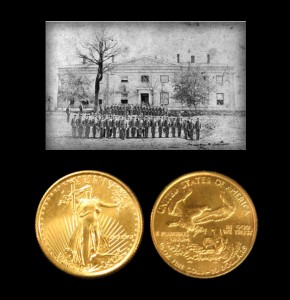Today, a modern Gold Quarter Ounce Coin tells the story of the Dahlonega Branch Mint and the gift of Congress 145 years ago.
President Andrew Jackson authorized The Act of 1835, which created three United States Mint production facilities in the South. In 1838, the first United States Mint branch facility opened in New Orleans, Louisiana. Shortly afterwards, the mint facilities in Charlotte, North Carolina, and Dahlonega, Georgia opened.
By 1838, the three southern mints were producing coins with mint marks “O” for New Orleans, “C” for Charlotte and “D” for Dahlonega.
The New Orleans branch produced both silver and gold coins, however the Charlotte and Dahlonega locations only struck gold coins.
In 1861, the Confederacy took control of the southern branch mints — New Orleans on January 8, Dahlonega on April 8 and Charlotte on April 20.
After the facilities were seized, sporadic coining operations continued along with the production of confederate money. Eventually, the Congress of the Confederacy converted the locations to perform assaying functions.
At the close of the Civil War, the three southern mint locations closed for good.
Five years after the Civil War, Congress agreed to provide the Dahlonega Branch Mint for educational purposes:
=====
CHAP. XXXI– An Act authorizing the Secretary of the Treasury to convey the United States Branch Mint at Dahlonega, Georgia, to the Trustees of the North Georgia Agricultural College for Educational Purposes.
Be it enacted by the Senate and House of Representatives of the United States of America in Congress assembled, That the Secretary of the Treasury be, and he is hereby, authorized and directed to convey to the trustees of the North Georgia Agricultural College, located in the town of Dahlonega, Georgia, the building known as the United States branch mint at Dahlonega, and the ten acres of land connected therewith, located on lot of land number nine hundred and forty-nine, in the twelfth district and first section of Lumpkin county; said conveyance to be made by the Secretary of the Treasury so soon as he is assured that said trustees have been properly incorporated by the laws of Georgia, and on the express condition that said building shall be used exclusively for educational purposes, and in conformity with the provisions of the act entitled “An act donating public lands to the several States and Territories which may provide colleges for the benefit of agriculture and the mechanic arts.”
Approved, April 20,1871.
=====
Two years later, North Georgia Agricultural College opened and became the state’s second oldest institution of higher education for the public.
From its beginnings, the college included a military education program with its primary focus on agriculture and mechanical arts, in particular, mining engineering.
As the area’s gold mining decreased and other schools addressed agricultural education, the college in Dahlonega evolved to emphasize arts and sciences.
In 1929, the college changed its name to North Georgia College.
In 1996, the college changed its name again to North Georgia College and State University in recognition of the wider scope of its educational offerings.
Just a few short years later in 2013, the college combined with other resources in the area to become the University of North Georgia.
Today, Price Memorial with its iconic gold covered tower rests on the location of the Dahlonega Branch Mint that unfortunately burned in 1878.
In its first year, the school became the first co-educational college in Georgia with 98 men and 78 women enrolled.
Today, as the University of North Georgia, over 16,000 men and women take classes at the schools multiple locations.
The Gold Quarter Ounce Coin shows below an 1877 picture of the men of the North Georgia Agricultural College performing military drills in front of the old Dahlonega Branch Mint building.
